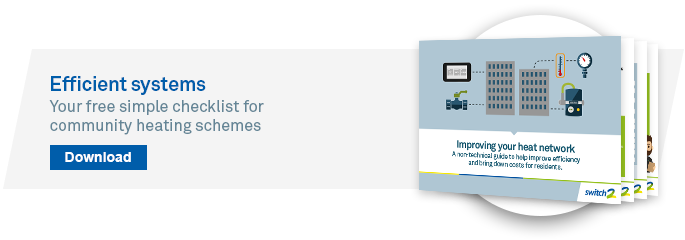A new range of heat interface units (HIUs) are making their way onto the market. Said to be the next generation of HIU, the connected successor enhances the benefits of operating an indirect connected heat network. But, could it be the product of choice for your heat network project?
But first, what is a connected HIU?
A HIU is similar to a traditional individual gas boiler, but instead of transferring gas to heat into the heating system, it transfers heat from the plant room to the internal dwelling’s heating system. A connected HIU is an electronic version of this; taking advantage of falling technology and communications costs, a connected HIU allows the unit to be electronically controlled allowing for adjustments and maintenance to be carried out remotely.
The difference between a mechanical and connected HIU is that the latter can communicate with other devices and most importantly, the operator and maintainer of the heat network. But whose job is it to ensure the heating system runs efficiently and reliably at least cost?
This is leading to a revolution on connected domestic appliances, bringing many benefits to a heat network:
1. Fault reporting: Fix the problem before there is one
By communicating with a HIU, faults can be reported before a resident is even aware of it. For example, if a strainer is blocked, or if there is low system pressure, or maybe temperatures are too low from the heat network; an alert is sent to the operator so that the correct adjustments can be carried out – all remotely. If a maintenance visit is needed it can be planned for a convenient time rather than as an expensive and inconvenient emergency call out. And why is this so important?
2. Simply put – happy customers!
When things don’t quite go to plan, (like the above examples) then alerts from the HIU to the operator will be received before the customer is even aware of an issue. This means the customer continues to receive a reliable, quality service and gives the operator the ability to be proactive, and if needs be, the opportunity to call the customer to fix the problem before service is affected.
This isn’t new technology to other industries, for example many cars now remotely report faults allowing garages to call their clients to make an appointment well in advance of a breakdown. This means better planning for everyone involved e.g. booking for suitable dates, managing workload and improving convenience.
3. Automatic meter reading (AMR): Two-way communications
In order to do any of this, there has to be an element of communication with the HIU. Using AMR is a straight-forward and efficient way of gathering accurate data from the system. Connected HIUs will report meter readings therefore negating the need for a separate AMR system simply used for metering. Meaning the system gets more ‘bang for its buck’ and allows for these cost saving benefits to occur.
4. Remote configuration and validation – making sure the system is commissioned correctly
Remote commissioning and validation reduces the cost of this process and brings transparency to proving the heat network is correctly performing and doing so optimally. This process then provides the operator with a window into each dwelling’s heat demand, allowing for system modifications to be made to improve efficiency and reliability. Furthermore, it means that the whole system can be optimised dependent on seasonal demands or network configuration changes.
5. Compliance reporting: SLAs and best practice
The CIBSE/ ADE Code of Practice CP1 outlines as a key objective that:
“(The HIU) should be designed to have low maintenance requirements and perform reliably over a long period of time.”
One way to do just that is built-in alerts from a HIU to the operator for required maintenance. Providing real-time data can also help make decisions on adjustments to the heat network flows and temperatures to the demand and set compliance for each individual heat network.
It’s clear that lowering system temperatures is a critical factor in the efficient operation of heat networks. By reducing the primary network temperature enables heat generation plant to operate more efficiently. A connected HIU can report any circumstance where a non-compliance is detected, such as over heating or low temperatures and response times.
6. Strengthen your asset management
As the data from each HIU is being reported in real-time, it means that operators and the heat network owner can better manage the heat network. For landlords, it means that temperatures can be monitored, providing mould protection at property level and safeguarding vulnerable customers.
7. Demand management: Giving transparency to the operator
Heat networks are often oversized to remove any risk of the heating system failing to meet peak demand which occurs on very few of the coldest days in the year, or perhaps on the few occasions where more residents choose to have a shower at the same time. Connected HIUs offer demand management features where demand can be limited at time of peak demand. This will give scheme owners and designers confidence to reduce sizing and margins of error.
Key takeaways
- The connected HIU is electronic and provides two-way communication giving heat network operators transparency the need to prove heat networks are performing optimally.
- Two-way communication means that faults and demand can be reported on in real-time, allowing the operator to manage the network more effectively
- Connected HIUs mean that heat network operators can be proactive, improving the service available to customers
- Remote configuration to HIUs increases certainty and reduces cost of installation and commissioning. It also allows operators to meet SLAs but improve upon them, meaning a better well-rounded transparent service
- The data made available also means that the network can be run much more efficiently, meaning reduced costs, reduced CO2 and increased customer satisfaction



